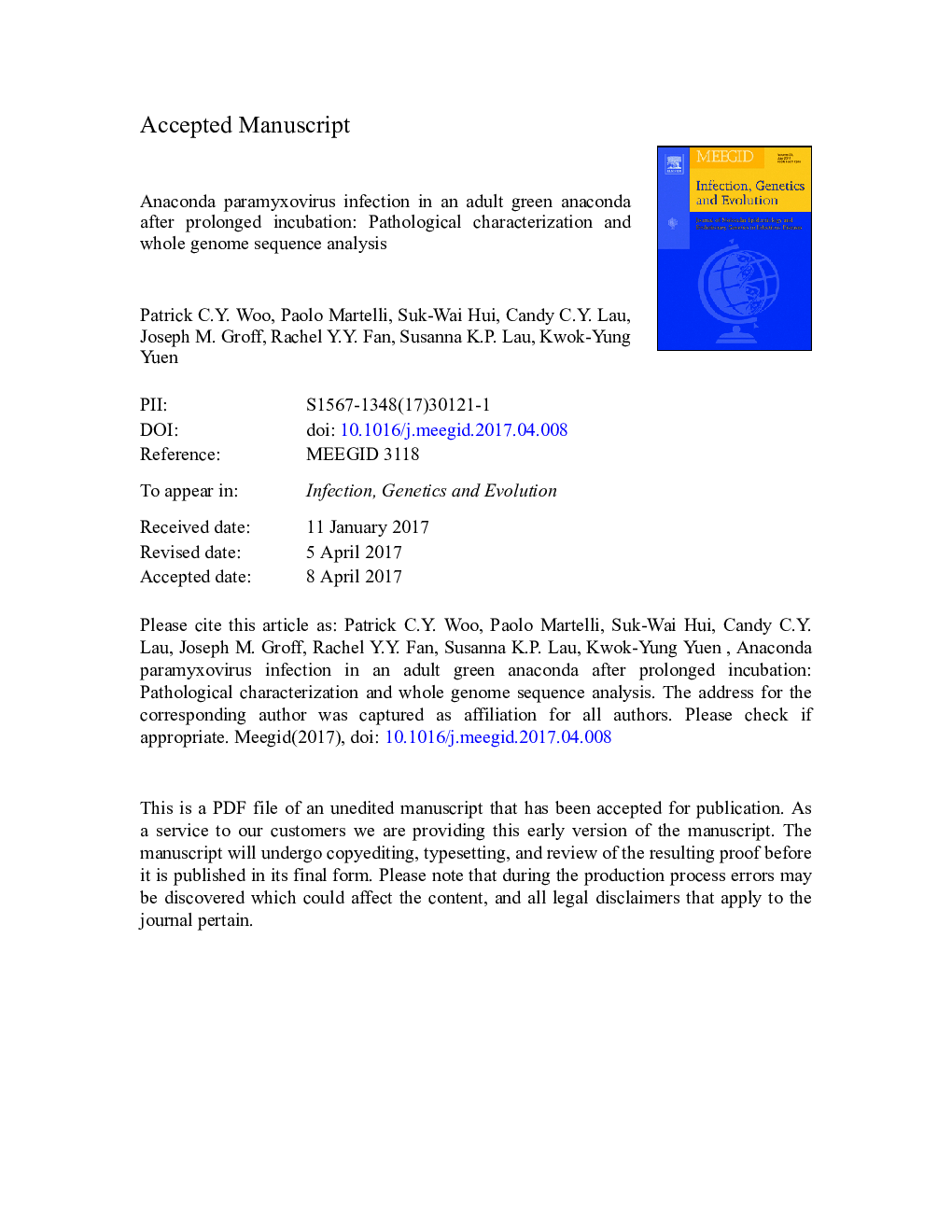| کد مقاله | کد نشریه | سال انتشار | مقاله انگلیسی | نسخه تمام متن |
|---|---|---|---|---|
| 5590444 | 1570152 | 2017 | 28 صفحه PDF | دانلود رایگان |
عنوان انگلیسی مقاله ISI
Anaconda paramyxovirus infection in an adult green anaconda after prolonged incubation: Pathological characterization and whole genome sequence analysis
دانلود مقاله + سفارش ترجمه
دانلود مقاله ISI انگلیسی
رایگان برای ایرانیان
موضوعات مرتبط
علوم زیستی و بیوفناوری
علوم کشاورزی و بیولوژیک
بوم شناسی، تکامل، رفتار و سامانه شناسی
پیش نمایش صفحه اول مقاله

چکیده انگلیسی
From July 2011 to June 2012, 31 out of 33 green anaconda juveniles from an oceanarium in Hong Kong died over a 12-month period. These anacondas were progeny of a female anaconda purchased from Japan and added to the collection in May 2011. The juvenile anacondas were born in July 2011. A novel paramyxovirus, named anaconda paramyxovirus (AnaPV), was isolated from these affected juvenile anacondas. In July 2015, one of the remaining two anacondas, that survived the cluster of fatal infections, died at the age of four. Pathologically, both the death of the four-year-old anaconda and the previous deaths of the anaconda juveniles involved multiple, similar organs. However, the organ that was primarily affected in the juvenile anacondas that died in 2011 was the kidney, whereas the most remarkable lesions in the four-year-old anaconda involved the lungs. Granulomas previously observed in the juvenile anacondas with AnaPV infections were not obvious in the four-year-old anaconda. RT-PCR for the L gene of AnaPV was positive for the lungs, kidneys, ovary, spleen, liver, tracheal content and gall bladder of the four-year-old anaconda, with a median viral load of 1.32Â ÃÂ 106Â AnaPVÂ RNAÂ copies/mg. Complete genome sequencing revealed that there were only 12-14 nucleotide changes in the AnaPV genome of the four-year old anaconda compared to those of the AnaPV found in anaconda juveniles in 2011/2012. Among these nucleotide changes, only four were non-synonymous mutations, with one in the N gene, one in the M gene and two in the HN gene. Both epidemiological and molecular data supported that the four-year-old green anaconda probably acquired the AnaPV from its mother or its siblings that died 3-4Â years ago, and its death is a result of an unprecedented extended incubation period or latency of AnaPV followed by a subsequent manifestation of clinical disease and death.
ناشر
Database: Elsevier - ScienceDirect (ساینس دایرکت)
Journal: Infection, Genetics and Evolution - Volume 51, July 2017, Pages 239-244
Journal: Infection, Genetics and Evolution - Volume 51, July 2017, Pages 239-244
نویسندگان
Patrick C.Y. Woo, Paolo Martelli, Suk-Wai Hui, Candy C.Y. Lau, Joseph M. Groff, Rachel Y.Y. Fan, Susanna K.P. Lau, Kwok-Yung Yuen,